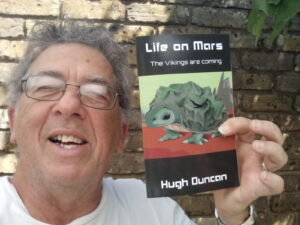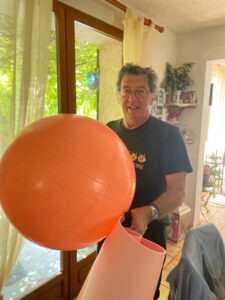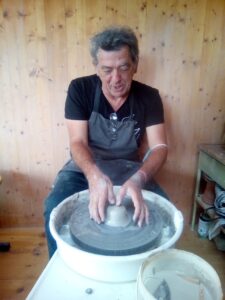Are earth life forms friendly or antagonistic; supportive, or mostly parasitic?
Are Earth Life-Forms Friendly or Antagonistic, Supportive or Mostly Parasitic?
Sarah Udoh-Grossfurthner Interviews: Hugh Duncan: Author of the Vikings (Life On Mars series).
Are earth life forms friendly or antagonistic, supportive or mostly parasitic?
Interesting questions, indeed, and ones that come quickly to mind as you read Vikings – Part 2 of Hugh Duncan’s Life On Mars. I can’t give proffer answers to these questions, of course. That is why I am turning today to the author of Vikings for their answers.
Sarah: First of all, Hugh, thank you very much for joining my readers and me today.
Hugh: Hello, Sarah, and thank you for inviting me to your blog. I appreciate you taking the time to feature Life on Mars.

Sarah: Besides giving us answers to the two questions above, please tell us a little about Vikings and your Life On Mars series.
Hugh: I think most life forms on earth are not friendly or antagonistic. They are merely doing what evolution has dictated for them. Some of the more sentient ones can be friendly, such as dolphins and humans (some of the time), but those same ones can also show such negative behaviours like vindictiveness, as observed among monkeys (and some world leaders, of course).
Sarah: Hahaha! It is interesting to link the behavioural patterns of certain world leaders to that of monkeys; not sure if some of them would thank you for that but…go on.
Hugh: Hahaha, oh well! Evolution has created supportive partnerships, as seen in symbiotic lifestyles, but evolution has also thrown up parasitic species. I don’t think they choose to be parasites, but among the more intelligent animals like humans, we often find such behaviours, don’t we?
Sarah: Are you saying the ‘parasitic’ patterns we see in certain life forms – and I am referring to humans here, are beyond the control of the life forms exhibiting them? That is, some humans are bad not because they want to be but because they cannot help being bad. If that be true, what would you say is the hope for certain persons, a prisoner who is pardoned, for example? Such pardons are often done with the understanding that such a prisoner will change and become a positive contributor to society.
Hugh: Sure, some people can change and are genuinely sorry, but others will use it like game theory and will say whatever is needed to improve their situation.
Now, back to Life on Mars. I have chosen to concentrate on the more positive traits of cooperation between species during a challenging time, though you do get some negative moments, like the sibling rivalry between Jade and Ruby and the infighting between the pyrites, but that spices up the story a little. The ‘baddies’ if you like, are those on the hard-of-thinking end of the spectrum like the Eschers, but that could just be blamed on their evolution. The other baddies tend to be more mischievous, like gravity artist Herman and the mindless zombie vegetables, which cannot seem to reason, anyway. However, the Physics Police do appear to be deliberately unpleasant. I guess they have emotional issues to sort out. A bit of Muddism might help them.
Sarah: Science Fiction works are often based on many suppositions: about planets, their life forms (if indeed they exist) and the way those life forms live. The conjectures that come out of these suppositions are sometimes a bit weird, to say the least. Your Life On Mars does follow this science fiction pattern, too, of course. However, yours goes a step further by being outlandishly funny and a bit, should I say…out there… in its many creative licenses. For example, we have a ‘voices-hearing’ electrostatic plant, a personified football-pitch-sized flying object, a liquid horse, some flying cats, house Martians from the South of France, a quantum tunnelling worm, and zombie vegetables. Not to mention Elvis – the father of the protagonist. Can you tell us how you came about these riotous combinations and managed to make them work?
Hugh: I do enjoy it when humour can be brought into other arenas. As a teacher, I always tried to come up with science-related jokes, for which my students would groan, but they would also remember the material a lot better e.g. charging a battery could be called ’re-Volting’ (shocking) now!). Terry Pratchett’s Discworld series works so well because the light humour that is liberally sprinkled throughout his books raises the appeal and some laughs.
Sarah: I totally agree. Humour in any situation lends a bit of lightness to the often seriousness of life. Besides, we could all do with a bit of laugh now and again, Hugh. Have you always been a writer? If not, what were you doing before you turned to writing?
Hugh: I have been writing all my life, but teaching has paid the bills. I trained to be a physics, science and maths teacher, which I did for over 40 years until recently retiring. I wrote a handful of stories before Life on Mars, which were never published. Then I wrote several Private Eye-type reviews for the staff at my school before doing a Terry Pratchett parody called Deskworld for the students and teachers about the school being for magical folk. This went on for over a decade and was the training ground for the Mars story. At the start of the third millennium, I actually had factual revision booklets published for IB physics, plus articles for the British Society for the Turin Shroud and articles for UCL’s Maths journal Chalkdust.
Sarah: The Turin Shroud? Wow! If I remember correctly, isn’t that about the controversial piece of material that was used to wipe the sweat off Jesus’s face when he was crucified? It is said his face and entire expression were transferred miraculously onto that piece of cloth, right?
Hugh: You are referring to Veronica Cloth, which might well be the same thing. The Shroud is a cloth kept in Turin that has the image front and back of a man that autopsy experts say shows all the signs of having been crucified. I became fascinated with it through the scientific research performed on the Shroud. It is a real-life detective story, more fascinating and intriguing than the Da Vinci Code story.
Sarah: Sometimes, true life stories can be weirder than fiction, right? Is Life On Mars series your first book?
Hugh: Yes, this one, ‘The Vikings Are Coming,’ is my first published work of fiction. If successful, it may well become a series, as I have many ideas for it in the pipeline.
Sarah: Awesome! We will be hearing more from Hugh Duncan, the author, then. What is coming after Life On Mars?
Hugh: Life On Mars-The Vikings Are Coming is the start of a possible series. I am working on a prequel called ‘Pyrites!’ from a million years before, about how Masha became captain and how humans were already a potential threat even during a previous Ice Age period. I also have a sequel underway called ‘One Of Our Tortles Is Missing’ about half the team taking a holiday on one of the Martian Moons after the Viking scare is over, with a hidden agenda raising the intrigue of why they went there. Otherwise, I am looking at the possibility of creating a cartoon strip/graphic novel with the illustrator of Life on Mars, Natascha Booth. It is about a sentient soap bubble called Billie, with some fun science thrown into the mix. We are even discussing a spin-off cartoon story about the two house martins from the Mars story, as they seem popular characters. I have started some three-dozen other science fiction stories over the years, so I may well revisit them, and maybe there are some gems there waiting to be completed…
Sarah: Wonderful! What is your goal for this book? What started you on the road to writing this particular series?
Hugh: I am more than delighted to have the book published. I like writing and just completing it for myself was the first goal. Anything else that comes from it is a bonus. It would be fantastic if people enjoyed the story as well. Of course, an animated movie would be a DreamWorks come true (will they be reading this?!).
Sarah: Hahaha, one lives in hope, right?
Hugh: Indeed! (chuckles). Anyway, back to answering your questions. In the summer of 1976, I was poised to study astronomy at university when the Viking craft landed on Mars. I let my mind start to run wild, well crawl slowly, as I imagined one of the rocks next to the lander was a camouflaged tortoise. The idea for the story grew from there. My final thesis was about Mars, and seeing all the dry rivers and dried-up seas in the photographs raised speculation about what might have happened in the past. If life could exist, I asked myself, by stretching the rules a little bit (?!), what could it be like? Thus, a plant that eats electrostatic energy was created, a magnetic cat that surfs the field lines, a non-Newtonian liquid horse and many other creatures whose existence is questionable. Still, at the same time, they push the curiosity button.
Sarah: Hugh, it’s been very interesting listening to your shares on Life On Mars, particularly the Viking. Our short interview has come to an end, unfortunately. Before we wrap up, is there something, in particular, you would like to share with your potential followers and readers of your series?
Hugh: Well, Sarah, to all the people who have already supported this project by featuring the book or investing in a copy, thank you so much for giving me this unique opportunity to share my joy of writing. I hope those who read it will have fun. For those yet to decide, please consider escaping into this lightly humorous adventure where the laws of physics have been twisted into an amusing shape that should make you smile. And to you, Sarah, thank you again for having me as a guest on your blog.
Sarah: Couldn’t have put it better, Hugh; the pleasure has been mine. Thank you.
END OF INTERVIEW
(P/S – If you would like to be interviewed and featured on my blog, drop me a note here: https://linktr.ee/Sudohgrossfurthner)
In the meantime…
For more on Hugh Duncan: VIKINGS and the LIFE ON MARS series, click on the links below:



Elsewhen: https://bit.ly/LifeOnMars-Vikings
The main buy links are as follows:
https://Books2Read.com/LifeOnMars
eBook:
https://books.apple.com/gb/book/id6443120642
https://bit.ly/LifeOnMars-Google
https://bit.ly/LifeOnMars-Kobo
https://bit.ly/LifeOnMars-NookUS
https://www.amazon.co.uk/dp/B0B61SSNVC
paperback:
https://www.amazon.co.uk/Life-Mars-Vikings-are-coming/dp/1915304024/
https://www.barnesandnoble.com/w/life-on-mars-hugh-duncan/1141765229?ean=9781915304025
https://www.bookdepository.com/x/9781915304025
Excerps from The Viking, Life on Mars
“Racing against time, Jade and her friends must hide evidence of Life on Mars to stop the probes from Earth from finding them.
Jade is on her way to meet up with her dad, Elvis, for her sixteen-millionth birthday (tortles live a long time in spite of the harsh conditions on Mars), when she gets side-tracked by a strange object that appears to have fallen from the sky. Elvis’ travelling companion Starkwood, an electrostatic plant, is hearing voices, claiming that “The Vikings Are Coming”, while their football-pitch-sized flying friend Fionix confirms the rumour: the Earth has sent two craft to look for life on Mars.
It then becomes a race against time to hide any evidence of such life before Earth destroys it for good. Can Jade and her friends succeed, with help from a Lung Whale, a liquid horse, some flying cats, the Hellas Angels, the Pyrites and a couple of House Martins from the South of France? Oh, and a quantum tunnelling worm – all while avoiding Zombie Vegetables and trouble with a Gravity Artist and the Physics Police?! A gentle and lightly humorous science fantasy adventure.”



Facebook Comments